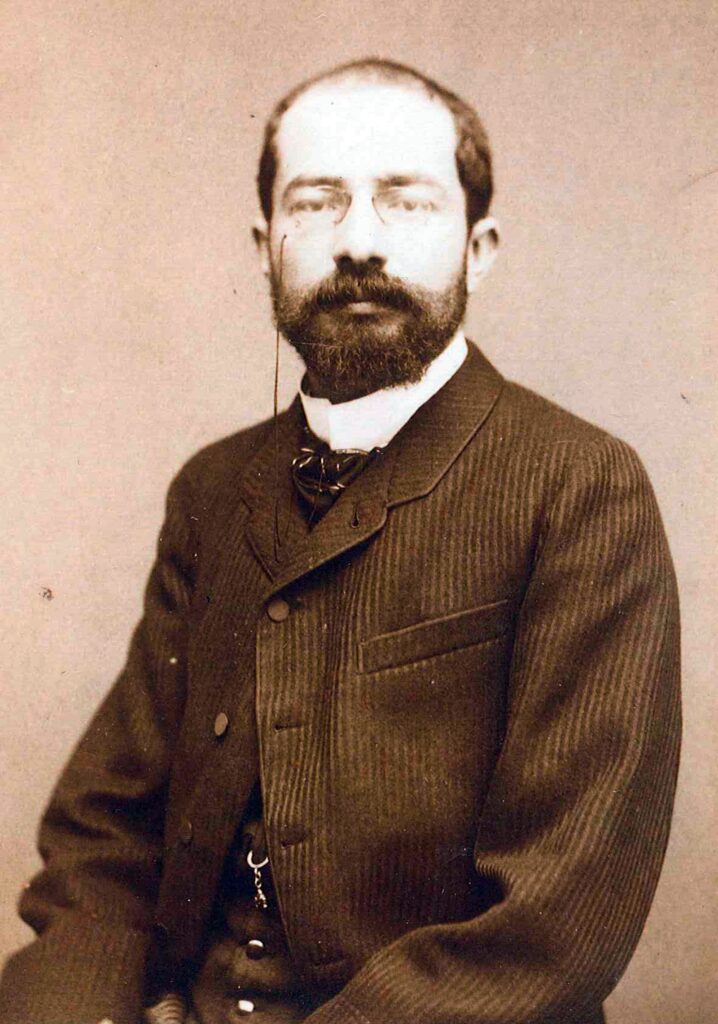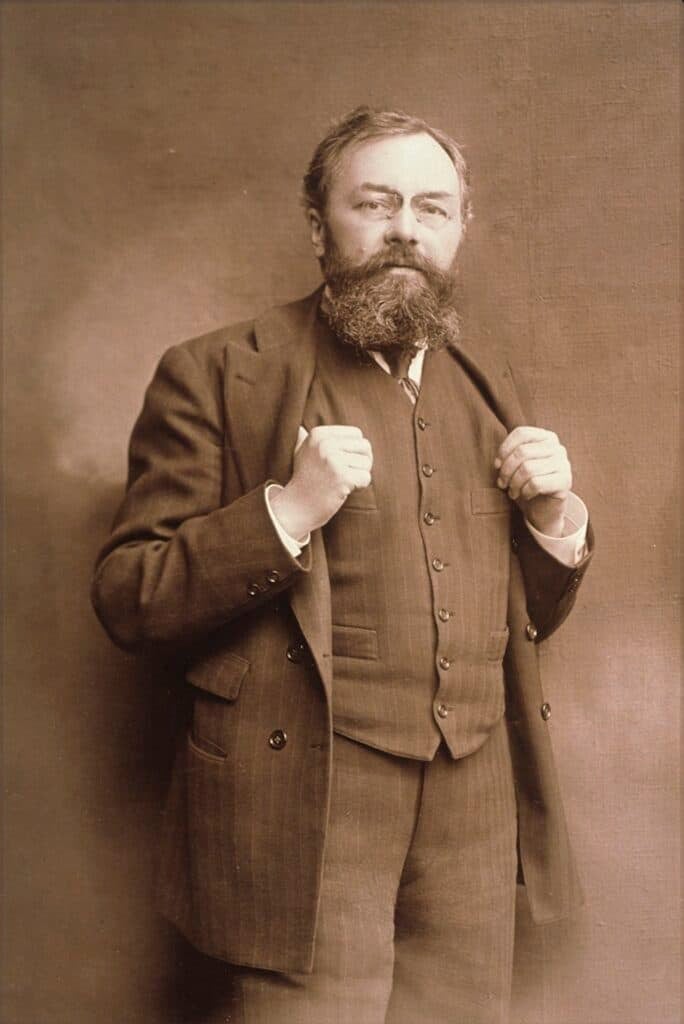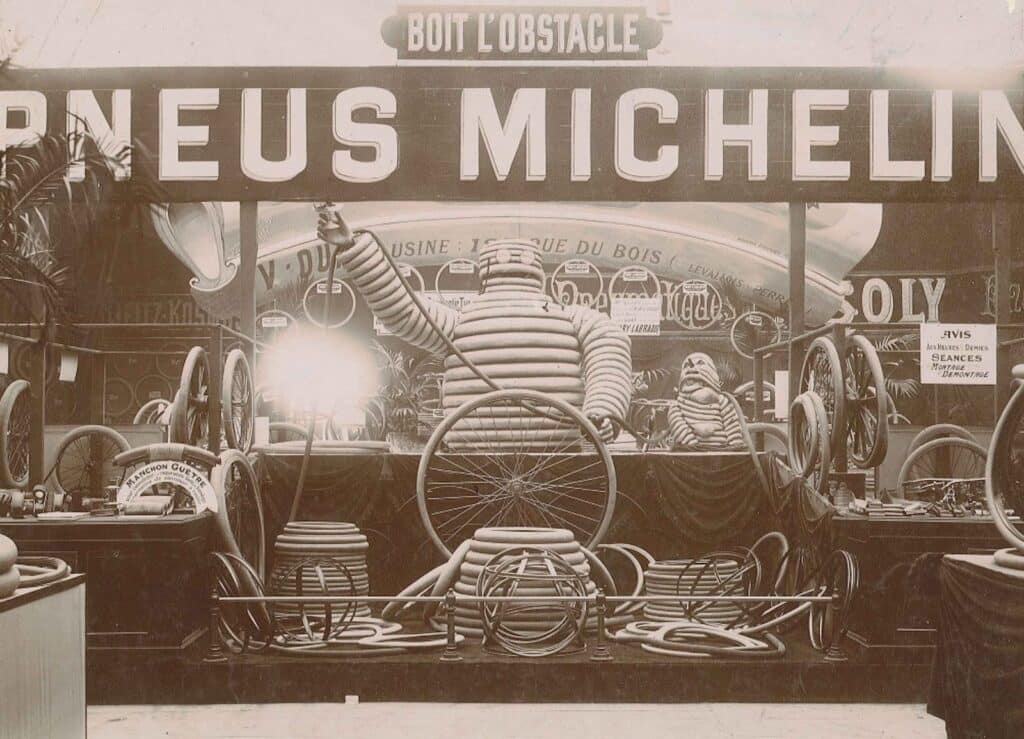
Being Monterey Car Week, it’s only fitting that we remember the year 1998, when a redesigned, slimmed down rendition of Bibendum, better known as the Michelin Tire Man, debuts at that year’s Monterey Historic Automobile Races in Monterey, California as part of a yearlong celebration of Michelin’s 100th anniversary.
One of the world’s oldest trademarks, Bibendum is a white, tubby, cuddly pile of white tires, one created by company founders Edouard and André Michelin. Today, he has a light-hearted countenance, but he didn’t start out that way.
Early days
The Michelin Tire Co. traces its roots to the early 19th century, in the wake of Scottish inventor Charles Macintosh, who discovered rubber was soluble in benzine.
Having made rubber balls for his niece, Elizabeth Pugh Barker, she started making rubber balls in 1829 using her uncle’s technique for the children of France’s Auvergne region. Her husband, Édouard Daubrée, created a machine to make the balls, and three years later he teamed up with his cousin Aristide Barbier to start a small factory in the town of Clermont-Ferrand, where their product range expanded to include farm equipment, which used rubber for the company’s hoses, valves, fittings, joints and other parts.
By 1864, both Édouard Daubrée and Aristide Barbier were dead, and Aristide’s daughter, Adèle, was left to deal with company creditors. Married to Jules Michelin, she turned to her sons André and Édouard, who took control of the company, changing its name to Michelin & Cie. The brothers sought new uses for rubber, leading the company to launch a brake pad for horse-drawn cabs and carriages called “The Silent” that went on sale in 1889.

But it wasn’t the brake pad that made Michelin the international household name its known as today. No, it was a cyclist who would change the company forever.
Chance encounter
That would happen in 1891, when a cyclist arrived at the company, looking for help in patching up his punctured Dunlop tire. The tire was glued to the wheel, which was effective, but difficult to fix. Repairing the tire not only required three hours, but it also needed to dry overnight. Édouard knew there had to be a better way to make bicycle tires, and attempted to invent one that would be far easier to repair.
This led to his creation of a tire with a detachable rim, which cut the required time to fix a flat tire to a mere 15 minutes. Riding on the new tires, cyclist Charles Terront won the 1891 Paris-Brest-Paris race more than eight hours ahead of the second-place winner, a testament to the ease of fixing a flat Michelin tire.
But with the creation of the automobile, and its growing sales, the brothers mounted their pneumatic tires on a car named The Éclair, which participated in the Paris-Bordeaux-Paris race in 1895. It didn’t win, but it was a first car to wear pneumatic tires.
A new mascot

But the origins of the Michelin Man date to the year before, 1894, when Édouard and André visited the Lyon Universal Exposition. After spotting a stack of tires on the Michelin stand, Édouard said to his brother, “Look, with arms and legs, it would make a man.”
The idea remained in their minds until 1898 when they met with French illustrator Marius Rossillon, known as O’Galop, to flesh out their idea. Rossillon was inspired by one of his previous advertisements, a rejected poster of King Gambrinus, the obese patron saint of breweries, that he had created for a Munich brewery. The king declared “nunc est bibendum” or “it’s time to drink.” The royal was replaced by a man made of tires, but the text remained.
Once the poster was completed, it was on display at the Paris–Amsterdam–Paris race in July of that year, when driver Léon Théry seemingly shouted to André Michelin, “voila Bibendum, vive Bibendum,” in turn, inadvertently naming the character.

Still, given the mascot’s modern-day friendliness, it’s striking to see his early sinister demeanor, wearing evil-looking glasses and brandishing a cigar or a glass of champagne. But the accoutrements helped target the company’s target audience, wealthy customers who could afford cars. No doubt this helped him survive, along with the tagline, “Michelin tires drink obstacles.”
But by 1929, the glasses and cigar would be gone, although the white tires remained, even though carbon black had been added to rubber tires since 1912.
The company would continue to manufacture tires, most notably creating the Michelin X in 1946, the world’s first radial tire, followed by the XAS, an asymmetrical high-performance sports car tire. It would acquire the Uniroyal-Goodrich Tire Company in 1990, and would grow to become the largest tire manufacturer in the world.
Through it all, Bibendum remains indelibly linked to Michelin, and was named by The Financial Times as the “Best Logo of the Century” in 2000.
Best of all, Bibendum is still with us 125 years later, still drinking up obstacles and making us smile.
- SEO Powered Content & PR Distribution. Get Amplified Today.
- PlatoData.Network Vertical Generative Ai. Empower Yourself. Access Here.
- PlatoAiStream. Web3 Intelligence. Knowledge Amplified. Access Here.
- PlatoESG. Automotive / EVs, Carbon, CleanTech, Energy, Environment, Solar, Waste Management. Access Here.
- PlatoHealth. Biotech and Clinical Trials Intelligence. Access Here.
- ChartPrime. Elevate your Trading Game with ChartPrime. Access Here.
- BlockOffsets. Modernizing Environmental Offset Ownership. Access Here.
- Source: https://www.thedetroitbureau.com/2023/08/the-rearview-mirror-more-than-a-pile-of-tires/



